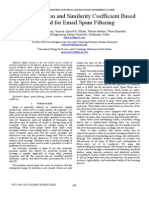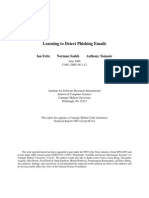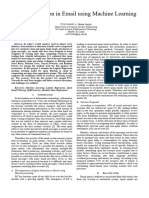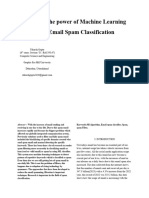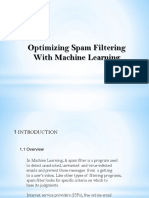ID3 Algorithm
ID3 Algorithm
Uploaded by
Hayat RajaniCopyright:
Available Formats
ID3 Algorithm
ID3 Algorithm
Uploaded by
Hayat RajaniOriginal Description:
Copyright
Available Formats
Share this document
Did you find this document useful?
Is this content inappropriate?
Copyright:
Available Formats
ID3 Algorithm
ID3 Algorithm
Uploaded by
Hayat RajaniCopyright:
Available Formats
EXPERIMENT 3
Information Search
Research & Design of ID3 algorithm rule-based anti-spam email filtering
What follows is a short report on the ID3 algorithm with respect to anti-spam email filtering
ID3 algorithm for anti-spam email filtering
Introduction: With the popularity of the Internet, email has become a common and important communication tool for the users using computers. However, one of the annoying sideeffects caused by the abuse of emails is the proliferation of the unsolicited commercial emails. The so-called unsolicited commercial email is defined as an electronic message in which (1) the recipients personal identity and context are irrelevant; and (2) the recipient has not verifiably granted deliberate, explicit, and still revocable permission for it to be sent; and (3) the transmission and reception of the message appears to the recipient to give a disproportionate benefit to the sender Other names of such messages include unsolicited bulk mail, excessive multi-posting, bulk email, junk email, or spam. Conversely, normal email is referred to as ham. Internet users unavoidably incur the cost of time spent consulting, identifying, and deleting spam. This does not include the cost of potential damage caused by viruses, consumer fraud and identity theft. Besides, spam causes costly productivity loss and wastes human resources on detecting and handling spam. Therefore, anti-spamming has been becoming an important issue for Internet users. Early spam filtering tools rely on black-lists, white-lists, and hand-crafted rules that search for particular keywords, phrases, or suspicious patterns in the headers or message bodies.
2|Page
Spam is commonly defined as unsolicited email messages and the goal of spam categorization is to distinguish between spam and legitimate email messages. The economics of spam details that the spammer has to target several recipients with identical and similar email messages. As a result a dynamic knowledge sharing effective defense against a substantial fraction of spam has to be designed which can alternate the burdens of frequent training stand alone spam filter. A weighted email attribute based classification is proposed to mainly focus to encounter the issues in normal email system. These type of classification helps to formulate an effective utilization of our email system by combining the concepts of Bayesian Spam Filtering Algorithm, Iterative Dichotmiser 3(ID3) Algorithm and Bloom Filter. The details captured by the system are processed to track the original sender causing disturbances and prefer them to block further mails from them. We have tested the effectiveness of our scheme by collecting offline data from Yahoo mail & Gmail dumps. This proposal is implemented using .net and sample user-Id for knowledge base.
Email: Electronic mail, commonly called email or e-mail, is a method of exchanging digital messages across the Internet or other computer networks. Originally, email was transmitted directly from one user to another computer. This required both computers to be online at the same time, a la instant messaging. Today's email systems are based on a store-andforward model. Email servers accept, forward, deliver and
3|Page
store messages. Users no longer need be online simultaneously and need only connect briefly, typically to an email server, for as long as it takes to send or receive messages. An email message consists of two components, the message header, and the message body, which is the email's content. The message header contains control information, including, minimally, an originator's email address and one or more recipient addresses and the body contains the message itself as unstructured text; sometimes containing a signature block at the end. This is exactly the same as the body of a regular letter. The header is separated from the body by a blank line.
Spamming Behaviour: The objective of sending spams is to sell products or services to the customers possibly available on the Internet. For this purpose, spams are massively and repeatedly dispatched in order to broadly contact potential customers. However, in order not to be detected, spams are elaborately pretended as hams. The pretending tricks usually have some or all of the following characteristics. The socalled spamming behavior is a method that spammers use for composing or delivering a spam for specific purposes, such as the ones mentioned above. In most cases, hams are composed and delivered normally and the values of all fields in the headers and syslogs are correctly and properly given. Conversely, the associated headers and syslogs of spams may contain inconsistent or abnormal information such as the boxed parts in Figure 1, which reveal the existence of
4|Page
spamming behaviors. The concept of spamming behaviors is first presented in which claims that such behaviors can be used for identifying spams. Based on this concept, we apply induction-based machine learning techniques for construction classification rules for spam filtering.
ID3 Algorithm: ID3 algorithm is an example of Symbolic Learning and Rule Induction. It is also a supervised learner which means it looks at examples like a training data set to make its decisions. It was developed by J. Ross Quinlan back in 1979. It is a decision tree that is based on mathematical calculations.
1. Decision Trees:
5|Page
A decision tree classifies data using its attributes. It is upside down. The tree has decision nodes and leaf nodes. In Fig 3, linkFromAcademias attribute is a decision node and the author attribute is the leaf node. The leaf node has homogenous data which means further classification is not necessary. ID3 algorithm builds similar decision trees until all the leaf nodes are homogenous.
2. Training Data and Set: ID3 algorithm is a supervised learner. It needs to have training data sets to make decisions. The training set lists the attributes and their possible values. ID3 doesnt deal with continuous, numeric data which means we have to descretize them. Attributes such age which can values like 1 to 100 are instead listed as young and old. Attributes Age Height Values Young, Old Tall, Short
6|Page
Employed
Yes, No
The training data is the list of data containing actual values.
3. Entropy:
Entropy refers to the randomness of the data. It ranges from 0-1. Data sets with entropy 1 means it is as random as it can get. A data set with entropy 1 means that it is homogenous. In Fig 6, the root of the tree has a collection of Data. It has high entropy which means the data is random. The set of data is eventually divided into subsets 3, 4, 5 and 6 where it is now homogenous and the entropy is 0 or close to 0. Entropy is calculated by the formula: E(S) = -(p+)*log2(p+ ) - (p- )*log2(p- )
7|Page
S represents the set and p+ are the number of elements in the set S with positive values and p are the number of elements with negative values. The purpose of ID3 algorithm is to classify data using decision trees, such that the resulting leaf nodes are all homogenous with zero entropy.
4. Gain: In decision trees, nodes are created by singling out an attribute. ID3s aim is to create the leaf nodes with homogenous data. That means it has to choose the attribute that fulfils this requirement the most. ID3 calculates the Gain of the individual attributes. The attribute with the highest gain results in nodes with the smallest entropy. To calculate Gain we use: Gain(S, A) = Entropy(S) - S ((|Sv| / |S|) * Entropy(Sv)). In the formula, S is the set and A is the attribute. SV is the subset of S where attribute A has value v. |S| is the number of elements in set S and |Sv| is the number of elements in subset Sv. ID3 chooses the attribute with the highest gain to create nodes in the decision tree. If the resulting subsets do not have entropy zero or equal to zero then it chooses one of the remaining attribute to create further nodes until all the subsets are homogeneous.
Weaknesses of ID3 Algorithm: ID3 uses training data sets to makes decisions. This means it relies entirely on the training data. The training data is input by the programmer. Whatever
8|Page
is in the training data is its base knowledge. Any adulteration of the training data will result in wrong classification. It cannot handle continuous data like numeric values so values of the attributes need to be discrete. It also only considers a single attribute with the highest attribute. It doesnt consider other attributes with less gain. It also doesnt backtrack to check its nodes so it is also called a greedy algorithm. Due to its algorithm it results in shorter trees. Sometimes we might need to consider two attributes at once as a combination but it is not facilitated in ID3. For example in a bank loan application we might need to consider attributes like age and earnings at once. Young applicants with fewer earnings can potentially have more chances of promotion and better pay which will result in a higher credit rating.
EXPERIMENTAL RESULTS AND PERFORMANCE EVALUATION: The spambase dataset is downloaded from the UCI machine learning repository[23] in the form of text file. This dataset contains 57 input attributes of continuous format and 1 target attribute in discrete format. Then feature construction is done for feature transformation. Since the training dataset contains all the input attributes as continuous and target attribute as discrete, the following four feature selection algorithms namely, Fisher filtering, ReliefF, Runs Filtering and Step disc are executed on this dataset for retrieving relevant features. Classification algorithms such as Naive bayes continuous, ID3 ,K-NN, multilayer perceptron, CSVC, Linear discriminant analysis, CS-MC4, Rnd tree, PLS9|Page
LDA, PLS-DA etc, are applied to each of the above filtering algorithms. Fisher filtering produces above 95% accurate results for 3 classifiers (C4.5, CS-MC4 and Rnd tree classification algorithms); above 90% accuracy for 8 classifiers and above 85% for 6 classifiers. ReliefF filtering produce above 95% accuracy for only 1 classifier (Rnd Tree ); above 90% accuracy for 6 classifiers; above 85% for 6 classifier and above 80% for 4 classifiers. Runs filtering and Stepwise discriminant analysis provides best result for 2 classifiers (C4.5 and CS-MC4); above 90% for 10 classifiers and above 85% accuracy for 5 classifiers. Runs filtering and Step disc feature selection algorithms almost provide the same result. From the results, the Rnd tree classification is considered as a best classifier, as it produced 99% accuracy through fisher filtering feature selection.
10 | P a g e
Conclusion: Email spam classification has received a tremendous attention by majority of the people as it helps to identify the unwanted information and threats. Therefore, most of the researchers pay attention in finding the best classifier for detecting spam emails. From the obtained results, fisher filtering and runs filtering feature selection algorithms performs better classification for many classifiers. The Rnd tree classification algorithm applied on relevant features after fisher filtering has produced more than 99% accuracy in spam detection. This Rnd tree classifier is also tested with test dataset which gives accurate results than other classifiers for this spam dataset.
11 | P a g e
You might also like
- Digital Agency ServicesDocument4 pagesDigital Agency ServicesArdanNo ratings yet
- Machine Learning with Clustering: A Visual Guide for Beginners with Examples in PythonFrom EverandMachine Learning with Clustering: A Visual Guide for Beginners with Examples in PythonNo ratings yet
- Unit IIIDocument10 pagesUnit IIIRamkrishnaNo ratings yet
- Spam Detection Using rANDOMIZED fOREST tECHINQUEDocument5 pagesSpam Detection Using rANDOMIZED fOREST tECHINQUEMohit SnggNo ratings yet
- Suspicious E-Mail Detection Via Decision Tree: A Data Mining ApproachDocument9 pagesSuspicious E-Mail Detection Via Decision Tree: A Data Mining ApproachPraneeth KusumaNo ratings yet
- 122 14211291439 13 PDFDocument5 pages122 14211291439 13 PDFNancy ParetaNo ratings yet
- Email PrioritizationDocument8 pagesEmail PrioritizationVidul ApNo ratings yet
- Feature Selection and Similarity Coefficient Based Method For Email Spam FilteringDocument4 pagesFeature Selection and Similarity Coefficient Based Method For Email Spam FilteringAadil KhanNo ratings yet
- Email Classification Using Naive Bayes Classifier: Domain Algorithms Framework PlatformDocument7 pagesEmail Classification Using Naive Bayes Classifier: Domain Algorithms Framework PlatformFHIT ChikkabanavaraNo ratings yet
- FICE Project Report SpamDocument14 pagesFICE Project Report SpamAnubhav YadavNo ratings yet
- ICavor Paper IT2021Document4 pagesICavor Paper IT2021Ivana MilašNo ratings yet
- Cmu Isri 06 112Document16 pagesCmu Isri 06 112420No ratings yet
- Emai Spam Detection Using Machine Learning and Python - IJRPR3714Document6 pagesEmai Spam Detection Using Machine Learning and Python - IJRPR3714abhiram2003pgdNo ratings yet
- Hybrid Machine Learning Based E-Mail Spam Filtering TechniqueDocument58 pagesHybrid Machine Learning Based E-Mail Spam Filtering Techniquevinith100% (2)
- Considering Behavior of Sender in Spam Mail Detection: S. Naksomboon, C. Charnsripinyo and N. WattanapongsakornDocument5 pagesConsidering Behavior of Sender in Spam Mail Detection: S. Naksomboon, C. Charnsripinyo and N. WattanapongsakornRavi PurneNo ratings yet
- A Model To Detect Spam Email Using Support Vector Classifier and Random Forest ClassifierDocument11 pagesA Model To Detect Spam Email Using Support Vector Classifier and Random Forest Classifierghazy almutiryNo ratings yet
- ASSIGNMEnt 3Document26 pagesASSIGNMEnt 3amandeep651No ratings yet
- A Comparative Approach To Email Classification Using Naive Bayes Classifier and Hidden Markov ModelDocument6 pagesA Comparative Approach To Email Classification Using Naive Bayes Classifier and Hidden Markov ModeleswarlalmechNo ratings yet
- (IJCST-V11I2P16) :shikha, Jatinder Singh SainiDocument9 pages(IJCST-V11I2P16) :shikha, Jatinder Singh SainiEighthSenseGroupNo ratings yet
- A Novel Method of Spam Mail Detection Using Text Based Clustering ApproachDocument11 pagesA Novel Method of Spam Mail Detection Using Text Based Clustering ApproachHitesh ವಿಟ್ಟಲ್ ShettyNo ratings yet
- Subject Based Efficient Spam Detection TechniqueDocument5 pagesSubject Based Efficient Spam Detection Techniques_mathanmeNo ratings yet
- A Comparative Performance Evaluation of Content Based Spam and Malicious URL Detection in E-MailDocument6 pagesA Comparative Performance Evaluation of Content Based Spam and Malicious URL Detection in E-MailCorporacion H21No ratings yet
- Module3 IdsDocument17 pagesModule3 Idssachinsachitha1321No ratings yet
- Email Spam Detection Using Naïve Bayes AlgorithmDocument5 pagesEmail Spam Detection Using Naïve Bayes AlgorithmIJRASETPublicationsNo ratings yet
- Automated Social Hierarchy Detection Through Email Network AnalysisDocument9 pagesAutomated Social Hierarchy Detection Through Email Network AnalysisAneeh SuhNo ratings yet
- Reverse of E-Mail Spam Filtering Algorithms To Maintain E-Mail DeliverabilityDocument4 pagesReverse of E-Mail Spam Filtering Algorithms To Maintain E-Mail DeliverabilityMadhu Raj SekharNo ratings yet
- Detection of Fake Accounts in Instagram Using Machine LearningDocument8 pagesDetection of Fake Accounts in Instagram Using Machine LearningAnonymous Gl4IRRjzNNo ratings yet
- Scrutinizing Unsolicited E-Mail and Revealing Zombies: V.Annie, Mr. G. Sathishkumar. B.E, M.E, Ph.D.Document5 pagesScrutinizing Unsolicited E-Mail and Revealing Zombies: V.Annie, Mr. G. Sathishkumar. B.E, M.E, Ph.D.International Organization of Scientific Research (IOSR)No ratings yet
- Presentation 3Document13 pagesPresentation 3ragavaharish463No ratings yet
- Spam Detection ThesisDocument6 pagesSpam Detection Thesiszyxnlmikd100% (2)
- Fraud Detection System: - Nikita Lawande - Prakarsha Dahat - Riya ThakurDocument14 pagesFraud Detection System: - Nikita Lawande - Prakarsha Dahat - Riya ThakurackrinNo ratings yet
- 2167TC1 LabDocument8 pages2167TC1 LabPrasad Rajendra KadamNo ratings yet
- ML Unit 1Document27 pagesML Unit 1SUJATA SONWANENo ratings yet
- Apache Spam AssassinDocument8 pagesApache Spam AssassinOgundare Segun GideonNo ratings yet
- Ijresm V6 I9 3 2Document5 pagesIjresm V6 I9 3 2alpegambarliNo ratings yet
- Unit 4 AI LASKDocument7 pagesUnit 4 AI LASKTEJASHREE KUMARNo ratings yet
- R. Divya, Ch. Aswani Kumar, S. Saijanani and M. PriyadharshiniDocument17 pagesR. Divya, Ch. Aswani Kumar, S. Saijanani and M. PriyadharshiniNorizwad Shah NasharudinNo ratings yet
- Data Mining by Evolutionary Learning (DMEL) Using HBaseDocument46 pagesData Mining by Evolutionary Learning (DMEL) Using HBaseAbhijan Carter BiswasNo ratings yet
- Ijret - Research Scholars Evaluation Based On Guides View Using Id3Document4 pagesIjret - Research Scholars Evaluation Based On Guides View Using Id3International Journal of Research in Engineering and TechnologyNo ratings yet
- Spam Email ClassifierDocument16 pagesSpam Email Classifiersaravanan iyerNo ratings yet
- Research Scholars Evaluation Based On Guides View Using Id3Document4 pagesResearch Scholars Evaluation Based On Guides View Using Id3esatjournalsNo ratings yet
- E-Mail Spam DetectionDocument8 pagesE-Mail Spam Detection22bca0141No ratings yet
- DWM Exp6 C49Document15 pagesDWM Exp6 C49yadneshshende2223No ratings yet
- Decision Tree ReportDocument29 pagesDecision Tree ReportIshan Dalmia100% (1)
- $RB0DCANDocument10 pages$RB0DCANahmedhossam26103No ratings yet
- Spam Classifier ReportDocument5 pagesSpam Classifier ReportGurprem SinghNo ratings yet
- Analysis of Email Fraud Detection Using WEKA ToolDocument5 pagesAnalysis of Email Fraud Detection Using WEKA ToolseventhsensegroupNo ratings yet
- Spam Email Classification Using Decision Tree EnsembleDocument8 pagesSpam Email Classification Using Decision Tree EnsembleImmanuel ReonNo ratings yet
- A Data Collection Scheme With Multi-Agent Based Approach For VSNSDocument5 pagesA Data Collection Scheme With Multi-Agent Based Approach For VSNSAnonymous kw8Yrp0R5rNo ratings yet
- Final Report - Smart and Fast Email Sorting: 1 Project's DescriptionDocument5 pagesFinal Report - Smart and Fast Email Sorting: 1 Project's DescriptionGautamSikkaNo ratings yet
- Spam Detection in Email Using Machine LeDocument8 pagesSpam Detection in Email Using Machine LeRahulNo ratings yet
- Spam Detection Using Compression and PSO: Conference PaperDocument10 pagesSpam Detection Using Compression and PSO: Conference PapersamNo ratings yet
- VBK23 Cse 041Document6 pagesVBK23 Cse 041preetraj710No ratings yet
- Minor Project SynopsisDocument12 pagesMinor Project SynopsisAshishJhaNo ratings yet
- Phishing Detection in E-Mails Using Machine Learning: Srishti Rawal Bhuvan Rawal Aakhila Shaheen Shubham MalikDocument4 pagesPhishing Detection in E-Mails Using Machine Learning: Srishti Rawal Bhuvan Rawal Aakhila Shaheen Shubham Malikamit mahindreNo ratings yet
- Categorization of Email Using Machine Learning On Cloud: AbstractDocument5 pagesCategorization of Email Using Machine Learning On Cloud: AbstractSiddhu SiddharthNo ratings yet
- Email (Research) 3Document7 pagesEmail (Research) 3utkarshgupta2430No ratings yet
- A New Decision Tree Method For Data Mining in Medicine: Kasra MadadipouyaDocument7 pagesA New Decision Tree Method For Data Mining in Medicine: Kasra Madadipouyaacii journalNo ratings yet
- Optimizing Spam Filtering With Machine LearningDocument35 pagesOptimizing Spam Filtering With Machine LearningPavin PavinNo ratings yet
- Workflow of A Machine Learning ProjectDocument12 pagesWorkflow of A Machine Learning ProjectashishNo ratings yet
- Banco de Oro Online BankingDocument1 pageBanco de Oro Online BankingCartagena JayNo ratings yet
- Chapter 8 ProbDocument11 pagesChapter 8 ProbCheska VergaraNo ratings yet
- Indra I-Csoc Cybersecurity Operations CenterDocument2 pagesIndra I-Csoc Cybersecurity Operations CenterAji SakaNo ratings yet
- Careerfoundry Competitive Analysis TemplateDocument13 pagesCareerfoundry Competitive Analysis Templatebrandonscheepers96No ratings yet
- ITE 291-Human Computer Interaction SAS#3Document10 pagesITE 291-Human Computer Interaction SAS#3Kristian Eisen Mingarine MenianoNo ratings yet
- Pingaccess 50Document289 pagesPingaccess 50teb brunNo ratings yet
- Tax Return Receipt ConfirmationDocument1 pageTax Return Receipt ConfirmationGelli QuidolesNo ratings yet
- Halt The Hackers: Justin Berman - Security EngineerDocument30 pagesHalt The Hackers: Justin Berman - Security EngineerMonotronikNo ratings yet
- Gautam Sharma ResumeDocument1 pageGautam Sharma Resumeayushipandeyy101No ratings yet
- CryptographyDocument7 pagesCryptographyZonia NillNo ratings yet
- Bitdefender Privacy Policy English VersionDocument10 pagesBitdefender Privacy Policy English VersionMil GustosNo ratings yet
- Introduction To HTMLDocument284 pagesIntroduction To HTMLAftab PopatiaNo ratings yet
- 101 Digital Marketing Tools PDFDocument35 pages101 Digital Marketing Tools PDFaddi kirosNo ratings yet
- GOOD GPG Reference Gpg-Com-4Document62 pagesGOOD GPG Reference Gpg-Com-4bacooNo ratings yet
- PAM Suite ComparisionDocument5 pagesPAM Suite ComparisionFeroz XwgNo ratings yet
- T18 - Microsoft Entra Id Conditional Access DemystifiedDocument28 pagesT18 - Microsoft Entra Id Conditional Access Demystifiedroberta.abreu93No ratings yet
- Chapter 4. Security in E-Commerce: What Is Ecommerce Security?Document11 pagesChapter 4. Security in E-Commerce: What Is Ecommerce Security?OPIO DENISNo ratings yet
- TR 0199-27-1215-1-EnDocument6 pagesTR 0199-27-1215-1-Enls-huntingNo ratings yet
- How To InstallDocument2 pagesHow To InstallumaNo ratings yet
- Types of Videos For Social MediaDocument4 pagesTypes of Videos For Social MediaWangari Lothaire RachealNo ratings yet
- Questions - Computer Crime - U4Document2 pagesQuestions - Computer Crime - U4api-298865320No ratings yet
- BRKSEC-3229-SDWan TroubleshootingDocument158 pagesBRKSEC-3229-SDWan TroubleshootingSEMİHNo ratings yet
- Cloud Security Implications For Finanical ServicesDocument9 pagesCloud Security Implications For Finanical Servicesxaheg73095No ratings yet
- Cisco IOS VTY NotesDocument2 pagesCisco IOS VTY NotesvujapizekNo ratings yet
- Assignment 3Document4 pagesAssignment 3Sankalp RaneNo ratings yet
- Public Key Infrastructure (X509 PKI) : Presented By: Ali FanianDocument37 pagesPublic Key Infrastructure (X509 PKI) : Presented By: Ali Fanianmouloud25No ratings yet
- Keyboard Usb Catalog: 14 February 2022 - UserDocument11 pagesKeyboard Usb Catalog: 14 February 2022 - UserkarimsopyNo ratings yet
- Class1 Maths (Ayesha)Document126 pagesClass1 Maths (Ayesha)KashfaNo ratings yet
- My Training - KnowBe4Document6 pagesMy Training - KnowBe4Gabriel CavalcanteNo ratings yet







